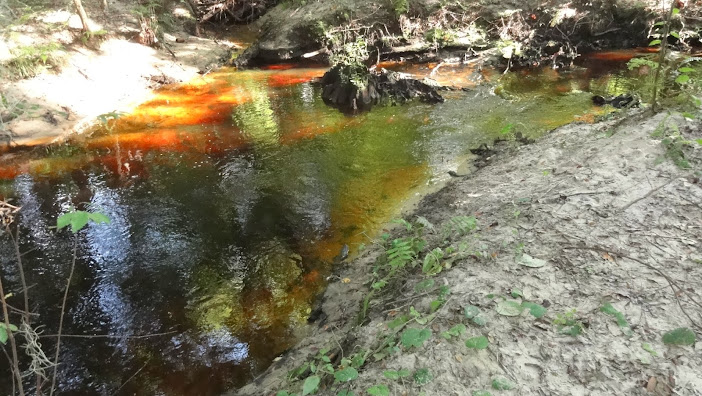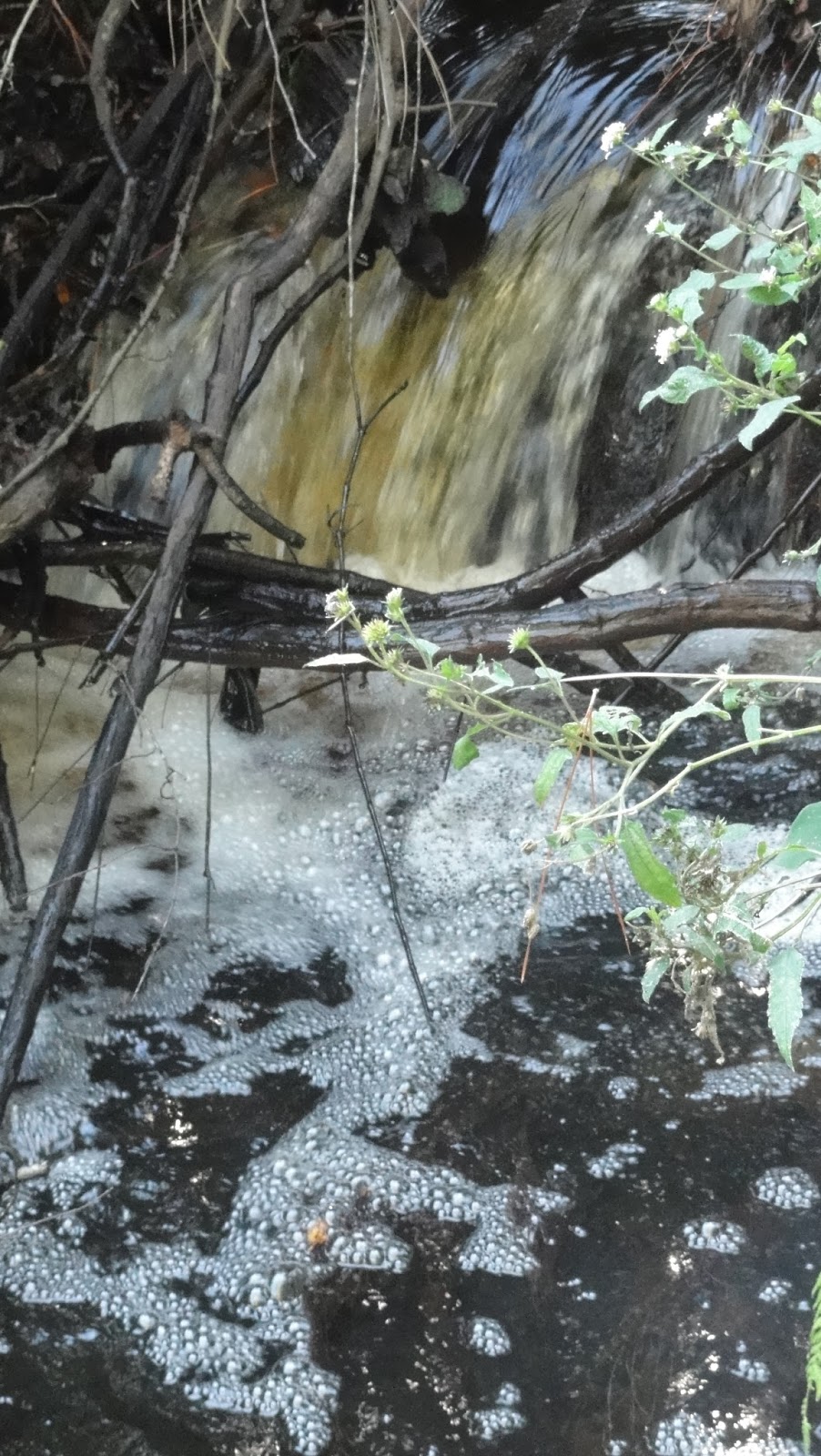The
Jacksonville Arboretum and Gardens is very young, as arboreta go. But it occupies an area that has a long history.
Timucuan people had inhabited the territory since perhaps 1100 AD. Spanish explorers arrived to the south in 1513, founding St. Augustine, Florida and spreading everywhere. In 1564,
French Huguenots under
Jean Ribault established a short-lived settlement at nearby
Fort Caroline until the Spanish wiped them out. Confederate and Yankee troops encamped just across the St. John's River at
Yellow Bluff from 1862 until the war's end.
Humphreys Gold Mining Company operated mines in this area of Jacksonville from 1944 to 1961 in search of titanium and other useful minerals. Sometime in the early 1970s, the
City of Jacksonville, Florida sought to build a waste-water treatment facility on the site, but the EPA required a buffer, probably to prevent accidental pollution of the
St. John's River. The city was forced to purchase extra property which remained undeveloped and mostly unused, except for illegal activities like, uh...dumping. Then in 2004, a group of concerned citizens envisioned its use as an arboretum. A lease agreement was worked out with the city, and arboretum development began in 2008. The rest is history.
When Jacksonville Arboretum and Gardens opened, a paved parking area and three walking trails had been established. Trails, benches, board walks, and picnic tables were built by volunteers. Brush clearing is still taking place. Plantings are young.
The .3 mile Lake Loop, one of the first established, features 2-acre Lake Ray, formerly a borrow pit. A borrow pit is a hole that remains when soil is moved to be used elsewhere. Actually, "borrow pit" is a misnomer because the soil is never ever returned. The water in Lake Ray comes from underground sources, direct rainfall and runoff. Water quality is actually pretty good. Most of the new plantings are in this area. The Lake Loop is reasonably picturesque.
A ravine to the south of Lake Ray, spring-fed and beautiful, was also a borrow pit. Two trails, Upper Ravine and Lower Ravine, allow visitors to explore it. Cabbage palms and longleaf pines inhabit the upper ravine; red maples (
Acer rubrum),
yellow poplar (Liriodendron tulipfera), oaks (
Quercus spp.), beautyberry (
Callicarpa americana), poison ivy (
Toxicodendron radicans), ferns and sedges inhabit the lower.
 |
| American Beautyberry, Callicarpa americana |
Snoop around in the ravine at the base of the ridge. You'll find yourself in a baygall. Water from runoff and springs collects there, and so do all kinds of interesting plants like bays. These won't be your typical bays like the leaves in your pantry or wreaths on your head, but their fragrances are reminiscent. You'll find
sweet bay (Magnolia virginiana), swamp bay (
Persea palustris), maybe its besieged relative
red bay (Persea borbonia), and
loblolly bay (Gordonia lasianthus). Other fragrant species will include
sweet gum (Liquidambar styraciflua), wax myrtle (
Myrica cerifera),
Virginia sweetspire (Itea virginica) and native azaleas (
Rhododendron spp.) Beneath them, you'll find lots of ferns.
 |
| Jones Creek, Jacksonville Arboretum |
|
Jones Creek, a charming freshwater attraction, begins in a subdivision near Regency Square Mall a few miles south, descends northward to the St. John's River through Jacksonville Arboretum. Creatures that should fascinate any child live in and around it including crayfish, possums, raccoons, salamanders and snakes. Barred owls often survey the scene below.
 |
| The Cascades |
Jones Creek is accessible via the Aralia Trail, so called because native
Devil's Walking Sticks (Aralia spinosa) grow near it. A sign pointing along a short trail spur to The Cascades piques the interest. Keep in mind this is Florida, so don't expect much of a cascade. It isn't. Though the babble and brook are inviting, don't drink the water. Upstream is not pristine.
The .5 mile Live Oak Trail loops through woodland just north of the Lake Loop. The
National Champion Loblolly Bay tree lives there. Many of the oaks (
Quercus virginiana) are over 100 years old. But a century is not old in these parts.
The Live Oak Trail provides access to the 1 mile Rosemary Ridge Trail. It crosses different native communities including a xeric hammock, rosemary and oak scrub, depression and wetland marshes.
A xeric hammock is like a dry island. The arboretum's xeric hammock is dry because it is sandy. Plant species include
palmettos, drought-resistant shrubs such as
sparkleberry (Vaccinium arboretum), fetterbushes (
Lyonia spp.), scrubby oaks (
Quercus spp.), and
Reindeer moss (Cladonia rangiferina).
Christmas lichen (Cryptothecia rubrocincta) is one of the more colorful appearing as a red and green plaster on the sides of trees.
 |
| Depression marsh, Jacksonville Arboretum | |
The Rosemary Ridge trail also skirts a depression marsh. Depression marshes begin as sinkholes where limestone strata has separated, and clay and sand have slid in. The clay forms a bowl which holds water. The amount of water in a depression marsh varies by season. Grasses dominate during dry season. Aquatic species dominate during wet season. Furthermore, the species grow in concentric rings around the marsh, responding to the amount of available water. Those requiring most water are found in the center. An educational sign posted at this depression marsh indicates the presence of
red root (
Lachnanthes caroliniana)
, a pioneer species that colonizes rapidly after human disturbance. That disturbance may have been the result of mining activity. Redroot is yet another indicator that the landscape is a healing scar.
Rosemary Ridge is not named for a lady or the familiar kitchen herb, but for another native genus,
Conradina. Though called False Rosemary, it's actually related to
Rosmarinus officinalis of culinary fame. It's interesting to note that
Conradina, named for botanist, Solomon White Conrad (1779-1831) is usually seen growing almost alone among other plants. That's because
Conradina releases chemical compounds called terpenes (think "turpentine") into the soil that inhibit the growth of competing species. Standoffishness has its advantages!
For the record, there is another similar-looking plant called
Florida Rosemary (Cerotina ericoides) that's found growing in sandy regions across the southeastern U.S. Inspect it, sniff it, wonder about it, but don't bother trying to cook with it. Florida Rosemary will do you no good.
The Jacksonville Arboretum and Gardens has a lot of potential. If you're
visiting Jacksonville, FL, stop by. You'll enjoy it. There's no admission charge, but consider supporting it. You can help by becoming a member, donating money and/or volunteer labor.
Return to
GoGardenNow.com.







